November
2007: Celebrating the Centennial of the Daily Newspaper Comic Strip
Mutt, Jeff
and Their Precursing Creator, Bud Fisher
One hundred years ago this month, the daily comic
strip was inaugurated in a
Mutt and Jeff attests to
the visual power of the comic strip. The
eponymous duo long ago ascended to the pantheon of American mythology: in common parlance, the names, seemingly
forever linked, always denote a visually mismatched pair, a tall person and a
short one. But as a comic strip, Mutt and Jeff enjoys another
distinction: it established the
appearance of the medium, its daily format.
Other
cartoonists (Clare Briggs, George
Herriman) may have strung their comic pictures together in single file
across a newspaper page before Mutt and
Jeff debuted on
Until Mutt and Jeff set the fashion,
newspaper cartoons usually reached readers in one of two forms: on Sunday, in colored pages of tiered panels
in sequence (some, like Winsor McCay's Little
Nemo in Slumberland, intended chiefly for children to read); on weekdays,
collections of comic drawings grouped almost haphazardly within the ruled
border of a large single-frame panel (directed mostly to adult readers). The daily cartoons were often found in a
paper's sports section and featured graphic reportage and comic commentary on
the doings of diamond, ring, track, and other arenas of athletic
competition. Harry Conway "Bud" Fisher was a sports
cartoonist on the San Francisco Chronicle,
and so, not surprisingly, the comic strip he launched that became Mutt and Jeff focussed on a
preoccupation of the sporting crowd—namely, betting. 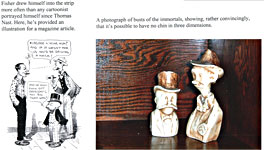
Some
accounts of the cartoonist’s life report that Fisher was born in Chicago on
April 3, 1884 (or 1885; sources differ), but in a 1915 news release prepared by
Wheeler Syndicate, Fisher is quoted as saying he was born in San Francisco,
April 3, 1885 —“but I didn’t stay there long. We moved about rather rapidly on
account of my father’s business. My mother and father lived in
By
1928, Fisher had changed his story. In a four-part article, “Confessions of a Cartoonist,”
published weekly in The Saturday Evening Post (beginning July
28), he says he was born in a suburb of
Bud
had no luck at first in finding a newspaper job in
Soon
after arriving at the Chronicle, he,
like most early cartoonists, was assigned to the sports department, where, for
the next couple years, he did layouts and occasionally drew pictures
celebrating in humorous imagery what proper society then regarded with
disdain—the dubious prowess and feats of professional athletes, their trainers,
managers, promoters, and hangers-on and other alleged riffraff. Fisher also
occasionally did pictorial reportage for other departments of the paper. Once
he was sent to interview Enrico Caruso, when the opera star came to town.
Caruso was well known as an amateur cartoonist as well as a celebrated tenor.
“He was great,” Fisher said, “and made a picture of me while I sketched him.”
A
short time later, on
Structures
that didn’t fall down burned. The city-wide conflagration was more impressive
than the earthquake: for years afterward, surviving locals referred to the
Fisher
scarcely imagined that he was establishing an art form. “In selecting the strip
form for the picture,” he wrote in “Confessions,” “I thought I would get a
prominent position across the top of the sporting page, which I did, and that
pleased my vanity. I also thought the cartoon would be easy to read in this
form. It was.” But Fisher’s editor had been a reluctant participant in the
experiment. Two years earlier, Young had turned down Fisher’s suggestion for a
similar “strip” because, he is alleged (by Fisher) to have said, “it would take
up too much room, and readers are used to reading down the page and not
horizontally.”
By
way of introducing and describing his cast, Fisher called his strip A. Mutt. "Mutt" was short for "muttonhead"—a fool (Eric
Partridge in Slang Today and Yesterday even credits Fisher with inventing the clipped version of the term). And Augustus Mutt was indeed something of a
fool: he was a compulsive horse-player,
a "plunger." And at first the
strip concentrated almost exclusively on his daily quest for the right horse to
bet on and for the wherewithal to place the wager. We saw Mutt's wife every once in a while—and
his young son, Cicero. But no Jeff. Jeff didn't come along until later.
In
those days before national syndication, a cartoonist drew only for his own
paper, and he generally drew a cartoon just the day before it would be
published. (Syndicates would require
cartoonists to submit their work weeks in advance because it took that much
production time to prepare the material for distribution all around the
country.) The circumstance permitted
extremely topical and local comedy: the
cartoon in today's paper could be based upon the news in yesterday's paper,
often news of city hall or the nearest police precinct house. Or, in the case of sports cartoons, the
playing field or race track. It was a
circumstance Fisher seized upon and exploited. In determining which horse Mutt would bet on in the strip to be
published in, say, Tuesday morning's paper, Fisher picked a real horse that
would be running Tuesday afternoon at the Emeryville track. Fellow racing enthusiasts had to wait for
Wednesday's paper to learn the outcome of Mutt's bet. Mutt lost mostly, but, given the vicissitudes
of wagering, he won every once in a while. And that was often enough. Readers of the strip began to take his wagers seriously, interpreting
them as inside tips. Almost overnight,
they were hooked, and their addiction guaranteed the strip's continued
appearance (not to mention continued sales of the Chronicle at the newsstand). Fisher was on his way to fame as well as fortune.
But
Fisher did more for the comic strip medium than establish its format. According to John Wheeler, founder of the
Wheeler (later Bell) Syndicate (distributor of Mutt and Jeff for most of the strip's run), Fisher, "by his
guts and independence, probably did more to make the cartoon business for his
more cowardly confreres than anyone else who has ever been in it." To begin with, Fisher had the foresight to
copyright A. Mutt in his own
name—and, later, to apply for a trademark on the title. The strip was his and no one else's. And Fisher fought in court to establish his
ownership beyond question.
Fisher
began to benefit from his prescience almost at once. Press baron William Randolph Hearst, seeing
that A. Mutt seemed responsible for
his competition's increase in circulation, did what he would do again and again
over the next half century: he hired the
rival's talent away by paying more. Much
more. Hearst offered a weekly salary of
$45, double Fisher's pay at the Chronicle; and A. Mutt began running in Hearst's San Francisco Examiner within three
weeks of its debut in the other paper. It also continued to run in the Chronicle. In accordance with established practice, A. Mutt was treated as if it were the Chronicle's property: the editors simply hired another cartoonist (Russ Westover, later the creator of Tillie the Toiler) to draw the
strip. But this time, the situation was
different. The canny Fisher had taken
the precaution of copyrighting the strip in his name with its last appearance
in the Chronicle.
In
the first of his “Confessions” articles, Fisher explained that after he had
accepted the Examiner offer but
before he left the Chronicle, he
consulted a lawyer about copyright and learned that “a copyright notice [had
to] be carried when the picture or article to be copyrighted was published and
then the drawings for three successive days had to be filed in the Patent
Office in Washington to complete the copyright.” Fisher had only one day left
at the Chronicle, but he used it:
after his editor had approved his strip for that day, December 10, the
cartoonist went into the engraving room before the strip was processed and
lettered into the last panel: “Copyright, 1907, by H.C. Fisher.” He did the
same on the first two strips published the next week in the Examiner. So when the Chronicle continued publishing the strip without Fisher, he brought
suit, and the paper, once persuaded of the legitimacy of his copyright holding,
dropped its claim. The last of the Westover strips appeared on
Later,
Fisher sued again for his rights to the strip, and this time, the case went to
court. In 1914, hearing that Fisher’s contract with Hearst was coming up for
renewal, Wheeler offered Fisher a better syndication deal than Hearst was
giving him. Hearst was then paying
Fisher $300 a week; Wheeler offered the cartoonist $1,000 a week or 60% of the
revenue, whichever was greater. It was a
staggering sum, but Fisher wasn’t convinced Wheeler could make good on the
offer. Wheeler finally persuaded him by depositing a year’s salary in an escrow
account. Fisher signed a contract in December 1914; his last strip for Hearst
was published
Wheeler’s
offer hadn’t been the first that tempted Fisher away from Hearst. Shortly after
arriving in
“My
friend,” said Fisher, “I don’t know who you are, but if you will guarantee to
fire me and make it stick, I’ll meet you at
Writing
his “Confessions,” Fisher concludes the tale: “I walked away, puffing my
cigarette and left a startled and dignified substitute general manager.
Needless to say, he didn’t fire me. I guess I was pretty fresh in those days.”
Fisher's
fights for his rights as a cartoonist were not confined to the courtroom. And the fighting began early. In his Comic
Art in America, Stephen Becker tells us that while Fisher was still a staff
cartoonist for the Chronicle, the paper
reduced the size allotted to his cartoon without informing him. Fisher calmly tore up his artwork and refused
to draw for the smaller size. In effect,
he quit. But since he was obliged to
give two weeks' notice, he came to the office every day for the next few days.
He did not, however, touch pen or paper. His editor soon relented, and Fisher's cartoon resumed at its usual
dimension.
Fisher
was perfectly constituted for doing battle. According to Rube Goldberg and others who knew him well, Fisher was an inlet of self-assured independence
in a churning sea of whimpering egos. He
was antagonistic and belligerent—a cocky, scrappy, dapper hard-drinking,
carousing denizen of city rooms and saloons. His was the sort of personality that generates legends. For example, there was his habit of using his
apartment as a target range, an incident recounted by Wheeler in his book, I've Got News For You.
While
waiting for his contract with Hearst to expire, Fisher was doing no
strips. To fill his idle hours, he went
with Wheeler on an expedition south of the border to interview Pancho Villa,
the bandit who had somehow become the savior of his country. Villa gave Fisher a six-shooter that he'd
taken from the body of a man whose execution Fisher and Wheeler had been
invited to watch. 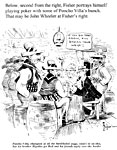
Fisher
took the pistol back to
"You're
too damn strict around here," Fisher said. "It is getting so you can't shoot off a pistol in your own place at
four in the morning without someone complaining. I'll move out tomorrow."
"You
bet you will," said the superintendent. And he did.
After
the Mexican adventure, Fisher resumed Mutt
and Jeff, this time for Wheeler, his first strip dated
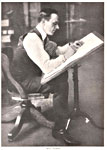 Fisher quickly habituated himself to enjoying both wealth and
renown. His celebrity made him welcome in circles that were normally closed to
newspapermen and other lowlifes (such as actors and professional athletes, all
of whom were social outcasts for at least the first twenty years of the
century). The first truly famous
cartoonist, Fisher relished his position in high society, and he worked hard on
his public image (tainting the world's perception of cartoonists in the
process). Fisher bought a stable of race
horses, drove about town in a Rolls Royce, and prowled nightclubs with a
beautiful showgirl on each arm. He
married one of them, Pauline Welch—“the prettiest girl I had ever seen in my
life.” The marriage didn’t last (“comic artists do not generally make good husbands,”
Fisher said), but their friendly relationship endured. “It is comforting to
know that in any emergency there is no one I could call upon and be surer of
assistance from than my ex-wife,” Fisher wrote in 1928. Although cartoonist
enjoyed the license of a bachelor life, in 1924 he married again, this time a
titled European whom he met on a voyage home from France, the Countess Aedita
de Beaumont, only to be legally separated four months later (but she inherited
62 percent of his estate, and subsequently, the strip’s copyright notice was in
her name).
Fisher quickly habituated himself to enjoying both wealth and
renown. His celebrity made him welcome in circles that were normally closed to
newspapermen and other lowlifes (such as actors and professional athletes, all
of whom were social outcasts for at least the first twenty years of the
century). The first truly famous
cartoonist, Fisher relished his position in high society, and he worked hard on
his public image (tainting the world's perception of cartoonists in the
process). Fisher bought a stable of race
horses, drove about town in a Rolls Royce, and prowled nightclubs with a
beautiful showgirl on each arm. He
married one of them, Pauline Welch—“the prettiest girl I had ever seen in my
life.” The marriage didn’t last (“comic artists do not generally make good husbands,”
Fisher said), but their friendly relationship endured. “It is comforting to
know that in any emergency there is no one I could call upon and be surer of
assistance from than my ex-wife,” Fisher wrote in 1928. Although cartoonist
enjoyed the license of a bachelor life, in 1924 he married again, this time a
titled European whom he met on a voyage home from France, the Countess Aedita
de Beaumont, only to be legally separated four months later (but she inherited
62 percent of his estate, and subsequently, the strip’s copyright notice was in
her name).
In
April 1917, the United States, until then resolutely neutral about the
hostilities in
When
he showed up at the training camp, Fisher reported, “I knew very little about
what people did before
On
weekends, Fisher took a hotel room in nearby
In
his account of his adventures as a soldier, Fisher somewhat coyly mentions only
that his were “special duties” that “kept me along the Western Front for
several months.” He confesses that he was assigned a “staff car, which gave me
a lot of freedom and an opportunity to visit the American Front—always by way
of
Fisher
says that he saw “considerable fighting,” but it must have been from a
distance. He adds, rather gracefully, “My experience at the Front was colorless
compared with that of other soldiers so I shall not dwell on it.” But he can’t
resist his comedic urge: “One thing that always amazed me was how easy it was
to slip by the front lines. There was no sign to tell you where they were until
you got shot at.”
One
of Fisher’s duties at the censor’s office was draw Mutt and Jeff for American publication. He send his weekly batches
of six daily strips back to the states from
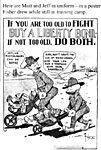
Fisher—and
Mutt and Jeff—served until the end of the War, and Beaverbrook had him created
a “perpetual” second lieutenant in the British army. Runyon lost his bet.
Almost
immediately upon Fisher’s discharge, Wheeler, responding to demand, contracted
with Fisher for a Sunday Mutt and Jeff. “I have never taken so great an interest in the page as in the daily pictures,”
Fisher said. “The Sunday page must necessarily be for children since it is they
who demand the funnies as soon as the newspaper comes into the house while the
strips are intended more for adult readers. I don’t think I have the point of
view of the child since I have never had one myself.” (Note that Fisher refers
to the daily releases as “strips” as distinguished from the Sunday version
which fills an entire “page” of the paper.)
Fisher
had another bias against the Sunday page. In order to allow for making the
color plates and subsequent matts for distribution to syndicate clients, the
Sunday version had to be produced several weeks in advance of publication date.
And Fisher “always contended that it keeps up the standard of the comic to draw
it as near the publication date as possible” in order to base his comedy “as
much as possible” on the news of the day.
By
the twenties, Fisher was enjoying his social life so much that he left most of
the work on the strip to Ed Mack. In
this respect, too, Fisher may have set the mold. For a long time, the average newspaper
reader, who acquired his perception of the world from what he read in his
paper, believed that the famous cartoonists whose escapades were so frequently
related on the front pages spent most of their time lolling around in fancy
nightclubs while their strips were being drawn by underpaid starving teenagers,
who slaved away in secrecy in some obscure garret. In Fisher's case, this perception was
probably close to the truth. (As it was
with another Fisher, Ham, whose Joe
Palooka was drawn by others even if it was written by its creator of
record.)
Bud
Fisher soon became a gambling, womanizing sun-dodger, who seldom handled a pen
anymore. And the more he moved in
society's salons, the less use he had for his erstwhile brethren of the
inky-fingered fraternity. He regularly
snubbed his one-time friends. "He
squandered his life and was a very unhappy man," Wheeler wrote.
Fisher
died in 1954 at the age of 70. His last
years were desolate and lonely. He was
sick and solitary in a huge museum of a
The
strip that made Fisher a wealthy celebrity graduated from pedestrian race-track
touting to classic comedy when the tall and gangling Mutt acquired his
diminutive side-kick: Mutt had
encountered Jeff among the inmates of an insane asylum in late March 1908, but
it wasn't until a year or so later that Fisher brought Jeff back into the strip
as a regular cast member. The skinny
tall man sort of adopted the short fellow, and the historic team was born. By then, the strip was appearing in Hearst's New York American, well on its way to
national distribution. Even before
Jeff's arrival, however, Fisher had pioneered another of the medium's
conventions—narrative that continues from one day to the next.
Fisher
had recognized at once the potential of the daily comic strip for bringing
readers back day after day after day. The central device of A. Mutt virtually forced the cartoonist into day-to-day continuity. Mutt places a bet one day; the outcome is
reported the next day. And Mutt promptly
places another bet. To learn whether
Mutt won or lost, we must buy a paper every day. But Fisher soon began to bait his hook with
other embellishments.
In
early January 1908, Fisher insinuated another storyline into the daily
ritual. Mutt's wife divorces him, and
Mutt begins paying court to another woman. Even in the throes of courtship, however, the plunger makes his daily
dash to the betting window. Despite his
addiction, he wins the lady's hand—only to lose her once and for all when he
deserts her at the altar in order to place a wager on a horse named Lazell
running in the Third Race that day. Subsequently, Mutt’s wife takes him back, telling him that the divorce
had been faked, a tactic she cooked up with a judge to jolt Mutt into
dependable domesticity. The scheme,
clearly, didn't work. They resume their
marriage, Mutt as devoted to the track as ever.
Obviously,
Fisher's strip was aimed at adult readership. Wagering is an adult diversion. And the strip appeared on the sports pages of the paper, a section
reflecting adult preoccupations. Obvious
factors but worth noting. The Sunday
funnies were conceived at least in part as entertainment for children. Not Fisher's strip. At first, he did seven strips a week, one for
Sunday and six for the weekdays. But the
Sunday strip ran in black-and-white on the sports page, not in the colored
comics section. He knew his
audience. And in deliberately appealing
to adult readership, Fisher once again set the pace for the medium. Although in the popular mind, the comics
still remain "kid stuff," they never were directed at youngsters in
the daily format: from the very
beginning, cartoonists wrote and drew their weekday comic "strips"
for adults.
In
yet another way, Fisher may have shaped the medium. This time, less commendably. There is ample evidence to indicate that
Fisher deliberately assumed a rudimentary drawing style for rendering the
adventures of Augustus Mutt. Fisher's
other cartoons for the Chronicle (some
drawn before he started A. Mutt; some
after) display a drawing ability that, while not spectacular, is accomplished,
better than merely adequate. 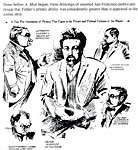 In fact, some of the pen portraits of Mutt that the strip's
continuity occasioned in 1908 show a command of the nuances of cross-hatching
and shading that is a cut above the skill otherwise revealed in the strip.
In fact, some of the pen portraits of Mutt that the strip's
continuity occasioned in 1908 show a command of the nuances of cross-hatching
and shading that is a cut above the skill otherwise revealed in the strip.
 Fisher
apparently believed that cartoons of the sort he was inventing with A. Mutt should be drawn in a crude almost
clumsy manner. I'm not talking about
Mutt's heron-like appearance—his beaky, chinless visage and tall rangy build or
his raw-boned, loose-limbed all-elbows-and-knees mode of locomotion. No, I'm talking about basic anatomy and such
other artistic fundamentals as simple perspective. In giving his protagonist human dimension,
Fisher was apt to change Mutt's proportions from one panel to the next: when he bent his arms and legs, they got
longer. And the characters very often
looked as if they didn't quite fit the surroundings Fisher gave them: chairs and doorways were too small, and
various furnishings tilted wildly to conform to Fisher's idiosyncratic
understanding of perspective.
Fisher
apparently believed that cartoons of the sort he was inventing with A. Mutt should be drawn in a crude almost
clumsy manner. I'm not talking about
Mutt's heron-like appearance—his beaky, chinless visage and tall rangy build or
his raw-boned, loose-limbed all-elbows-and-knees mode of locomotion. No, I'm talking about basic anatomy and such
other artistic fundamentals as simple perspective. In giving his protagonist human dimension,
Fisher was apt to change Mutt's proportions from one panel to the next: when he bent his arms and legs, they got
longer. And the characters very often
looked as if they didn't quite fit the surroundings Fisher gave them: chairs and doorways were too small, and
various furnishings tilted wildly to conform to Fisher's idiosyncratic
understanding of perspective.
To
the extent that A. Mutt provided a
model for others to emulate—and as the roaringly successful first of its kind,
the strip's influence was considerable—Fisher demonstrated the way a comic
strip should be drawn—crudely. His
influence in this regard was not, fortunately, pervasive. Cartoonists like Winsor McCay who had a
towering talent drew in the way their talent dictated and produced art works of
great beauty. Even artists with less
skill were driven mostly by their gifts, and, drawing as well as they could,
they created reasonably accomplished pictures. But Fisher had opened a door, and through that door, many less talented
artists could now pass. More
significantly, Fisher, perhaps unwittingly, gave the reading public the
impression that comic strips should be ineptly rendered. It was an image the medium would carry for
years—decades. Regardless of how popular
comic strips became (and they were very popular indeed from the very
beginning), for much of their early history, comic strips were seen as
sensational, amateurishly drawn appeals to the baser instincts of newspaper
readers. And for that, the vulgarities
of Richard Outcault’s Yellow Kid was partly responsible; and Bud Fisher must
surely shoulder his share of the blame, too.
Speculation
about Fisher's impact upon comic strip graphics and upon the public perception
of the artistic merit of comic strips aside, it's clear that when Fisher
launched A. Mutt, he defined the new
genre almost at birth. A. Mutt presented itself as a
"strip" of pictures, its narrative was continued from day-to-day, and
it was aimed deliberately at an adult audience. At this late date in the study of comic strips (we've been pondering
them seriously at least since about 1970), it may come as a surprise that the
first of the breed burst upon the pages of a San Francisco newspaper with
virtually all of the medium's conventions in place at the very onset. Upon reflection, though, it is not quite so
astonishing. As Samuel Johnson said of
Jonathan Swift's Gulliver's Travels,
"When once you have thought of big men and little men, it is very easy to
do the rest." With newspaper
cartoons, once the decision had been made to format them in "strips"
and run them daily, the rest—continuity from day-to-day, even adult readership—
follows logically. And these elements
were not the last of Fisher's innovations. He continued to play with the medium, and over the next two years, he
explored many facets of the form that others would take up again in later
years.
For
the first two months of his new strip's run, Fisher repeated essentially the
same gag every day, seven days a week. The punchline was Mutt's daily bet, and the last panel in every strip
showed Mutt dashing up to the betting window, knees and elbows a-flap with the
exertion of his desperate haste, a few dollars clenched in his fist. Fisher varied the daily drill in one of two
ways: Mutt's predicament on one day
might be determining which horse to bet on; on another day, his dilemma might
be how to acquire enough money to place a bet.
Mutt
often overhears a phrase in the discourse of passers-by and, taking the phrase
as some sort of omen, he bets on a horse whose name he hears in that
conversational fragment. Mutt's
compulsion is overpowering. He can be diverted
from any endeavor by chancing upon a phrase or a word that suggests which pony
to play that day. He jumps in the bay to
rescue a woman from drowning, and when she drops a word of gratitude, Mutt
abandons her to her fate in order to get to the track in time to bet on
"Thanks Be." He has a heart
attack as a result of some betting misfortune, but on his sick bed, he hears
his doctor recommend rest and "sea air," so he leaps out the hospital
window to place a bet on "Sea Air" to win. He even arises from the dead to get to the
track. Stricken by "apoplexy,"
Mutt dies and is buried. In the grave,
he overhears the grave diggers discussing that day's races, and when they
mention Pullman as a sure thing, Mutt bursts out of the earth and makes his
customary last-panel sprint to the betting window.
To
get money to bet, Mutt finds employment as a policeman, the first of many
miscellaneous jobs he'll hold over the years. But he can't keep the job: he
runs off to the track every time he hears the name of a horse. Eventually, he steals from Cicero's piggy
bank, sells the family parrot, hocks the bathtub and, eventually, the clothes
off his back.
The
comedy in these early strips arises entirely from Mutt's run of bad luck and
his overwhelming obsession. But Mutt
doesn't always lose. Because Fisher was
picking the names of real horses that ran in real races, Mutt sometimes
wins. And when he does, Fisher keeps
track of the size of Mutt's bankroll, recording its dwindling (or increasing)
amount in the last panel of each daily installment. Fortunately for the strip's comedy, Mutt loses
more often than he wins, so he never has a stake large enough to quell for long
the general feeling of frantic desperation that seems to animate him. Then on a fateful day in early February 1908,
the "great plunger," as usual in need of cash, steals money from a
pay phone. This development started
Fisher on a fresh course for his strip—and, as before, he explored new ground
for the medium.
For
a week or so, Mutt remains a fugitive from justice. He eludes the police, but he still makes his
daily dash to the track to place a bet. Caught at last, he is brought to trial, and Fisher stretched the
proceedings out for the next six weeks. Mutt still makes a wager in the last panel on most days, but the real
interest in the strip is generated by the trial. And to the natural suspense that a trial
might create, Fisher added a titillating device: the prosecuting attorney and the various
minions of the law surrounding him are devised to remind readers of several
local politicians who were engaged in a crusade to clean up the city government
of San Francisco.
In
the months of reconstruction following the earthquake, municipal graft had
flourished, inspiring a commendable civic effort to expunge the corruption.
“Reform ran mad,” wrote Bogart Rogers in American
Mercury (December 1954), and “a cabal ruled the city with a pious but iron
hand.” A grand jury handed down 383 indictments, and the trials began. The
investigation was financed by Rudolph Spreckels, who employed “a magnificently
mustached recruit from the Secret Service, William J. Burns,” who later
achieved fame by running down the culprits who blew up the Los Angeles Times building. The leading prosecuting attorney was
Francis J. Heney, “darling of the muckrackers,” who was succeed by an ambitious
young lawyer, Hiram W. Johnson.
“There
were no dull moments during the graft prosecutions,” said Rogers. “Prosecutor
Heney was shot and seriously wounded by a prospective juror named Hass, who
subsequently committed suicide in his jail cell. Police Chief W.J. Biggy was
fished, dead, from San Francisco Bay in a did-he-jump-or-was-he-pushed mystery.
The home of the star prosecution witness was wrecked by a bomb. ... Safes were
cracked; evidence stolen.”
But,
Rogers continued, “the prosecution faltered; convictions were few and far
between.” And San Franciscans were frustrated, then bored, then unhappy—then
ashamed that their city appeared so disreputably in the nation’s spotlight.
Fisher saw the entire enterprise as an opportunity: “I began to kid the
investigation in a good-natured way,” he wrote. Caricatures of the principals
in the investigation showed up in the same roles at Mutt’s trial. “I named them
after things to eat,” Fisher said in “Confessions.” Heney appeared as Attorney
Beaney; Spreckels as Pickles; a lawyer named Shortridge was Short Ribs.
Detective Burns was christened Tobasco. In his book, Wheeler elaborates on
Fisher’s method: “Fisher once saw Burns in a Turkish bath, he says, with curl
papers in his mustache, the great detective’s most pronounced facial
characteristic. The next morning in the strip, Burns was shown wearing curl
papers in his mustache. Throughout the rest of the trial, Burns made his daily
entrance with the curl papers in his mustache, much to Mr. Burns’ own chagrin.
In fact, there are some spectators who say Mr. Burns even let the corners of
his famous mustache droop for a time.”
The
references by which Fisher jogged the memories of his readers are obscure
today, but in the winter of 1908, they were doubtless clanging alarm bells in
the minds of those who read the strip. And Fisher rang the bells every day, day after day, mentioning “curl
papers,” “the $30,000" and one dignitary's "goat" (which Fisher
"got"). As political satire,
this sort of thing was pretty thin. But
as outright ridicule, heavy-handed though it was, it probably delighted
Fisher's readers: the barely veiled
references amounted to name-calling in public, a sensationalized novelty for
the embryonic comic strip form (even if the same techniques were common
practice in the news columns of many newspapers of the day).
According
to Rogers, the laughter Fisher incited gave San Franciscans a much needed
reprieve from the national humiliation their city was suffering daily as the
“graft prosecutions” dragged on without resolution. The title of his American Mercury article is “Augustus
Mutt: Hero of San Francisco.” Said Rogers: “The town grinned, smiled, guffawed
hilariously as day after day Fisher’s sharp and perspicacious pen cut the
reformers to ribbons. He did with laughs what others had failed to do with
countless solemn editorials and pompous speeches. It was widely agreed that he,
more than any other factor, stopped the Donnybrook which was saddening San
Francisco and ruining her municipal reputation.” Amid the laughter, the trials
were permitted to fade away.
Depicting
Mutt’s trial in the newspaper, Fisher continued in the spirit of
experimentation that had inspired the initial appearance of the strip. He toyed
with the incipient form, capitalizing upon its daily recurrence and the medium
in which it appeared. He converted his
strip from a narrative of sequential visuals to a miniature newspaper. Each daily installment featured a succession
of pictures, "newspaper photos," of the principals with accompanying
captions as Fisher reported the daily developments in the Mutt Case. The strip
assumed a new "voice"—the voice of the front-page headlines of a
daily newspaper.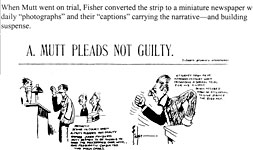 Fisher would use the device again later
in the year; and the technique would be refined twenty years later by Roy Crane
in Wash Tubbs.
Fisher would use the device again later
in the year; and the technique would be refined twenty years later by Roy Crane
in Wash Tubbs.
The
trial is of interest today for yet another reason: it brought us to the immortal Jeff. Mutt is found guilty, of course (he was
guilty, after all), but he is released after serving only a couple days because
of suggestions of malfeasance among the officers of the court. The constant references to the corruption of
the real city government thus opened the way for Fisher to free his
protagonist. But Mutt's sanity was
brought into question during the trial, and as soon as he is released from
jail, he finds himself committed to a local insane asylum. (Fisher skimps on the reasons for this
development; and so, therefore, must we.) In the "bughouse," Mutt meets such
historic personages as Shakespeare, George
Washington, the Czar of Russia, and assorted millionaires, poets, kings, and
captains of industry. Among these
deluded souls is a short bald fellow with muttonchop whiskers who believes he
is James Jeffries, the heavyweight boxing champion of contemporary notoriety
(particularly on the sports pages where A. Mutt appeared). Little Jeff at
last has arrived, wandering on stage March 27, 1908.
Jeff
(called Jeffries for many of his earliest appearances) is the bughouse fall
guy. The other inmates are always playing tricks on the poor boob. But he doesn't seem to mind. As Fisher put it, "What's the diff? He's just as happy as if he had good
sense."
Jeff
did not immediately become Mutt's ever-present side-kick and comic
factotum. He was, rather, just another
member of the strip's growing cast. When
Mutt is released from the asylum, Jeff occasionally visits the plunger—usually
in the company of "General Delivery," another of the inmates. Through most of April and May, however,
Fisher resumed his ridiculing of the city's corrupt politicians, using the same
"newspaper format" approach as he had used during Mutt's trial. For a time, the strip ceased to be a
"strip"—a narrative sequence of drawings—becoming instead a series of
daily tableaux that poked fun at the foibles of local politicians. (All of
these strips can be witnessed in the 1977 Hyperion Press book, A. Mutt.)
When
the 1908 Presidential campaign began heating up that summer, Mutt was again linked
with Jeff. Mutt is the Bughouse Party
nominee for President, and Jeff is the other half of the ticket. This may be the first time a comic character
ran for the U.S. Presidency (and Mutt and
Jeff will do it again several times), but Fisher did not much exploit this
rich vein of material. In fact, he uses
the campaign as an excuse to reprise his now-familiar needling of San Francisco
politicos. He must have enjoyed this
sort of thing a great deal, and he probably was encouraged by public reception
of the maneuver, but the constant chorus of the same material ($30,000, curl
papers, the goat) makes dull reading in later years.
On
Election Day in November, Jeff returns to the strip (as does Mutt). Jeff makes periodic re-appearances over the
next year, eventually proving himself the ideal foil for Mutt. By mid-1909, Jeff is a regular cast member,
appearing frequently, and in July, according to historian Allan Holtz in The Early Years of Mutt and Jeff, the
strip was officially entitled Mutt and
Jeff. But according to the court papers of the 1915 legal skirmish with
Hearst, the first time the names were coupled in print was in 1910 when a
booklet reprinting a selection that year’s strips was published with the title The Mutt and Jeff Cartoons. (Fisher
filed copyright papers dated September 22, 1910. He applied to trademark the
name on November 14, 1914, just as his contract with Hearst was coming up for
renewal; the trademark was granted March 9, 1915. Hearst, meanwhile,
anticipating Fisher’s departure and hoping to secure the strip’s name for a
successor to perpetuate, began using Mutt
and Jeff as a title of the strip on December 11, 1914—but only in the New York American not in other
newspapers to which the strip was syndicated.)
Fisher
had widened the scope of his strip's focus very early in its history, as we've
seen, by turning from horse-playing to politics (from one kind of horse-play to
another, we might say). He did it
deliberately: he aimed to broaden the
appeal of the strip. And he continued to
search for ways to make Mutt and Jeff interesting to the widest possible readership. He saw that many entertainers achieved success by appealing to the
special interests of a particular group. He reasoned that "if Mutt and Jeff appealed to everyone—high-brow,
low-brow, man, woman, and child—their value to me would be much greater."
Although
he subsequently determined that "the high-brow sense of humor does not
differ much from the low-brow," he decided his other distinctions were
valid. "So I worked out a
scheme," he wrote in American
Magazine of May 1920, "which I have followed ever since. Mutt and Jeff do something one day that will
tickle the women; the next day, the kids; the next day, I try to give the old
man a laugh. If Mutt hits Jeff across the
face with a fish, Father says, `That isn't funny!' Mother sniffs and looks away without a
grin. But the small boy yells. The next day, Mother gets the laugh. And finally, I squeeze a grin out of
Father. After a while, it gets to be a
habit."
With
the emergence of Little Jeff as Mutt's partner, the strip acquired the humane
dimension that made it a classic: it
ceased to be solely a daily chorus about crass money-grubbing and became a
cautionary tale about the human condition. Mutt remained the scheming conniver that he'd always been as a
horse-player: his role in the strip was
to come up with ways to make a buck. Jeff's seeming mental deficiency made him the perfect innocent, the
ideal foil for Mutt the Materialist. And
the strip's comedy soon took its vintage form with Mutt's avaricious
aspirations perpetually frustrated by Jeff's benign and well-intentioned
ignorance. Foiled by the little man's
uncomprehending bumbling, Mutt often responds with classic vaudevillian
exasperation: the strips' punchlines are
frequently precisely that, punches. In
the best slapstick tradition of the stage, Mutt lets his pesky partner have it
in the face with a pie, a dead chicken, a brick, or whatever object he happens
to have in his hand when he realizes the little runt had scuttled yet another
scheme with his literal-minded stupidity. Being beaned with a brick was a classic Mutt and Jeff finish long before George Herriman took the same
device and turned it into krazy katty poetry. 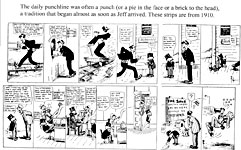
Often
deploying gentle Jeff as his shill in a succession of careers and enterprises
together, Mutt sometimes conceives plans that have the incidental effect of
victimizing the little fellow. But we
always root for Jeff: visually, the
short guy is the underdog, and most American readers cheer for the underdog out
of cultural habit. As usual, Fisher was
perfectly aware of what he was doing:
"Mutt
is a big, simple-minded boob who is always trying and always blundering,"
Fisher once said. "The great
majority of people like Jeff much more than they do Mutt; but Mutt always has
been my pal and friend. Mutt is trying,
and making mistakes, just like the rest of us, and he is a rough worker at
times. People like Jeff because he is
smaller, and almost every person in the world is for the little guy against the
big one."
And
Little Jeff in his innocence and kindliness justifies our faith. Regardless of Mutt's machinations, Jeff
invariably winds up on top, unwittingly victorious over whatever traps or
pitfalls may have lain in his path. So
does the benevolent nature of humankind seem somehow to triumph eventually over
its baser instincts in the long, long run. We laughed at them both, but we merely tolerated Mutt and his schemes;
we loved little Jeff.
Fisher
and his assistants were able to work endless variations on their simple
theme. It wore well. The strip ran for over 75 years.
When
Ed Mack died in 1932, the strip was inherited by his sometime assistant, Al Smith. Albert Schmidt was born March
2, 1902, in Brooklyn, New York, the son of Henry Schmidt and Josephine Dice.
After attending public schools, he started in newspapering as a copy boy for
the New York Sun, leaving within a
year for the New York World, where he
followed the traditional apprenticeship route from copy boy to cartoonist:
first, he was permitted to assist other cartoonists, then he drew an occasional
fill-in cartoon, and eventually he graduated to his own regular feature. As he
launched into his cartooning career, Smith married Erna Anna Strasser on May
25, 1921. Smith’s From 9 to 5, a
panel cartoon about office life, was syndicated by the World until the newspaper folded in 1931. United Feature Syndicate
continued the strip for a short time, but when it ceased, Smith freelanced,
doing artwork for various clients, including the Works Progress Administration
and John Wheeler’s Bell Syndicate, where, presumably, he assisted Ed Mack from
time to time. When Mack died, Wheeler approached Smith about ghosting the
strip.
Smith
told the story in the newsletter of the National Cartoonists Society, The Cartoonist, on the occasion of
Fisher’s death in 1954: 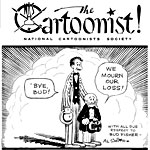 “It was during the Depression years, when my wife and I had three
small girls, and I was digging ditches for the WPA in New Jersey, that I
received a phone call from John Wheeler, president of Bell Syndicate, to come
over and see him. Bud Fisher needed an assistant artist to help him with Mutt and Jeff. My wife brought the good
news in our Model T Ford while I was in mud up to my ankles digging on the job.
I threw my shovel to one side and bid my associate ditch diggers a fond but
quick good-bye, and away I went to Mutt and Jeff, and I’ve been with them ever
since.”
“It was during the Depression years, when my wife and I had three
small girls, and I was digging ditches for the WPA in New Jersey, that I
received a phone call from John Wheeler, president of Bell Syndicate, to come
over and see him. Bud Fisher needed an assistant artist to help him with Mutt and Jeff. My wife brought the good
news in our Model T Ford while I was in mud up to my ankles digging on the job.
I threw my shovel to one side and bid my associate ditch diggers a fond but
quick good-bye, and away I went to Mutt and Jeff, and I’ve been with them ever
since.”
Fisher
was not particularly easy to work for, Smith discovered: “Very few people
really know—or should I say ‘understood’—Harry Conway (Bud) Fisher. He somehow
struck me as being an individual with a dual personality. It seems he was right
on the line of being an ordinary person and a genius if there is such a line
between the two. I never knew how I would find him. One day, he would be kind,
gentle, understanding and appreciative, and the next, hell in all its fury
would break loose. A whole week’s work of comic strips would be destroyed by a
few strokes of his brush, dripping with black ink. Good was not good enough,
and right there, I think, likes the secret of his success. He always wanted the
best in everything, and he usually got it. At the time, it was very difficult
for me to understand this man. He was so different from everyone else. Early in
my career with him, he had me on the point of a nervous breakdown. I left him
and went away for a week to rest, coming back with the determination to conquer
this most unusual job. The years started to roll by and after quitting four
times and being fired once—and in each instance the following day being called
on the phone as though nothing had happened—I began to understand Mutt and
Jeff’s creator.
“Much
of the time in later years, he was ill and confined to bed in his apartment. He
was always afraid of being trapped in a fire. He never used an ashtray but
would always drop his cigarette butts into a basin of water which stood by the
side of his bed.
“We
became very close friends as the years passed by. I had many pleasant visits
with him when he would reminisce until three or four in the morning and tell me
all about the big and little events in his life. I’m a good listener, and he
liked a good listener. He could talk for hours, going from one subject to
another. I hope I brought him some joy and happiness for in his passing years,
he was a lonely man.”
Despite
the sporadic interference from the flamboyant and heavy-drinking Fisher, Smith
ably conducted the classic strip, eventually revamping it to suit his own
comedic sensibilities. Mutt became less a race track tout and sporting
enthusiast and more a paterfamilias and bread winner. The habitual gambler was thoroughly domesticated, and the
strip focused on his frustrations as husband and father, with occasional forays
into various entrepreneurial schemes. Smith’s penchant for humorous animal
antics yielded a secondary strip, Cicero’s
Cat (about the cat that belonged to Mutt’s son), in a feature that ran at
the top of the Mutt and Jeff Sunday
page. After Fisher died in 1954, Smith was permitted to sign his own name to
the strip, which he continued to do until he left it at the end of 1981, having
produced the feature over four times longer than its creator did. Smith died
five years later, November 24, 1986.
Smith’s
graphic style was more polished than that of his several ghostly predecessors
on the strip, but he nonetheless preserved the turn-of-the-century feel of the
visuals. By the end of the 1930s, the faces and anatomy of his cast had
crystallized into static doodles, stylized glyphs of human appearance,
embellished by the cross-hatching and shading techniques of the earlier era.
In 1950, he inaugurated his own feature syndicate,
the Smith Service, to provide comic strips and cartoons to weekly newspapers.
For this purpose, Smith produced two features, Rural Delivery and Remember
When. Other similarly folksy offerings included Down Main Street by Joe Dennett and Pops by George Wolfe. Active in the National Cartoonists Society,
Smith held several offices (treasurer for nine years) before being elected
president (1967-69). In 1968, his NCS colleagues awarded him the organization’s
trophy for the year’s Best Humor Strip.
In
late 1981, while Smith was still cranking out Mutt and Jeff, a coup was fomenting in the back alleys of the
syndicate. The strip was appearing in only about 40 papers, cartoonist Jim Scancarelli told me, and various of
the powers-that-were began to murmur disconsolately about it. Speculation grew
that Mutt and Jeff would do better if
it were somehow up-dated, modernized, brought into the twentieth century. An
agent, one-time syndicate employee and now a freelance prospector in feature
properties, hearing the murmurs, thought of George Breisacher.
Breisacher
was a staff artist and cartoonist at the Charlotte
Observer in North Carolina, where he had been for the last seven or eight
years. Born August 24, 1939, Breisacher had explored several occupations before
settling on cartooning. After graduating from high school in 1957, he’d worked
as a mail carrier until 1963 when he “involuntarily” entered the Army, playing
clarinet in the 158th Army Band. He left the martial musical
profession in 1965 and began to pursue a career as a newspaper
cartoonist/artist, “doing everything I could do to gain experience,” he said. A
series of jobs landed him at the Pontiac
Press in Michigan in 1967 and then, in 1973, at the Observer. In 1978, he began producing a daily comic strip with
United Feature: called Knobs, it was
about television. The strip ceased in 1980, and Breisacher thereupon embarked
upon an ambitious effort to re-enter syndication with another strip. He
submitted candidates for consideration with such frequent regularity that his
name was familiar at the syndicate and known to the freelance agent, who, as
1981 dwindled, phoned Breisacher and asked him if he’d like to take over an
old-time classic strip. Breisacher, momentarily without another strip idea to
submit, said he’d like to consider it, and the agent invited him to New York to
discuss the matter. Scancarelli, who, as we shall see, was in a position to
know, told me what happened next.
Breisacher
found himself having lunch with the agent who had invited Al Smith to join them.
During lunch, the agent, to Breisacher’s astonished consternation, told Smith
that the syndicate was unhappy with his work on Mutt and Jeff, felt the strip needed a shot of adrenalin, and was
going to ask Breisacher to administer the needed nostrum.
“So
Smith didn’t know he was on the way out when he came to lunch?” I asked
Scancarelli.
“That’s
what George told me,” said Jim. “Big surprise.”
At
the time, Scancarelli continued, Breisacher didn’t know which of the Mutt and Jeff characters was the tall
one and which was the short one, but he accepted the assignment for the sake of
the challenge. He did the strip for the first couple weeks of 1982, but,
according to Scancarelli, he modernized the look of the feature so much that
subscribing newspapers began to complain.
“George
drew it like no one had ever seen before,” Jim told me. “It was unique.”
The
syndicate asked him to tone down his treatment and draw the strip in a somewhat
less extravagant manner, which Breisacher, as it turned out, didn’t want to do.
Having concocted the new, modern style, he evidently didn’t want to scale it
back into something akin to the traditional Fisher-Smith manifestation.
Whatever the cause, Breisacher phoned his Charlotte friend and fellow
cartoonist Scancarelli, who was at the time assisting Dick Moores on Gasoline
Alley.
If
second acts are almost never as good as first acts in syndicated comic strips,
third acts are completely unheard of. And yet, Gasoline Alley has enjoyed both the impossible and the unheard of. Moores, born in 1909, performed the
impossible when, after a four-year apprenticeship on the strip, he took it over in 1960 at the retirement of
its creator, Frank King; and
Scancarelli, born in 1941 (coincidentally, on August 24, same date as
Breisacher but a few years later), did the unheard of when he succeeded Moores
at the latter’s death in 1986. Before becoming Moores’ assistant in 1979,
Scancarelli worked as a commercial artist, first in television (he made the
first color animated movie for a local tv station in his hometown, Charlotte),
then, freelance, preparing slide art. When computers came along, capable of producing slide art faster and
cheaper than an artist, Scancarelli was suddenly out of work. That’s when he joined Moores, eventually inking
everything on the strip except the characters’ faces. And then came Mutt and Jeff.
Starting
with the January 18, 1982 release, Breisacher wrote and Scancarelli drew Mutt and Jeff for the next eighteen
months, until the strip, finally, expired with its June 25, 1983 release. Their
tenure embraced the strip’s 75th anniversary on November 15, 1982,
and when, eleven years later, Gasoline
Alley passed the three-quarters century mark, Scancarelli became the only
cartoonist to have worked on two strips in their seventy-fifth year. 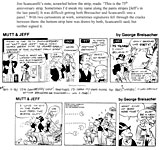 At first, Breisacher
turned the strips over to Scancarelli with the speech balloons lettered and
inked, but Scancarelli soon asked him not to ink the lettering: “George was a
good gag man,” Jim said, “but Mutt was a tall character, and sometimes George’s
speech balloons didn’t leave me enough room at the top of the panel to draw
Mutt at full length. With penciled speech balloons, I could shift things around
to make room for drawings.”
At first, Breisacher
turned the strips over to Scancarelli with the speech balloons lettered and
inked, but Scancarelli soon asked him not to ink the lettering: “George was a
good gag man,” Jim said, “but Mutt was a tall character, and sometimes George’s
speech balloons didn’t leave me enough room at the top of the panel to draw
Mutt at full length. With penciled speech balloons, I could shift things around
to make room for drawings.”
One
of Breisacher’s gags yielded an unexpected consequence. 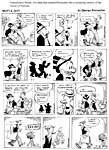 The punchline gave Newark, New Jersey,
a negative glow, and the mayor promptly dispatched a letter to Breisacher, forbidding
him to ever set foot in the precincts of his fair city—“or even to fly over
it!” Scancarelli said. “Some folks take their comics seriously!”
The punchline gave Newark, New Jersey,
a negative glow, and the mayor promptly dispatched a letter to Breisacher, forbidding
him to ever set foot in the precincts of his fair city—“or even to fly over
it!” Scancarelli said. “Some folks take their comics seriously!”
Scancarelli thought Smith’s drawing style was entirely adequate, but he didn’t want to draw it that way: it tied the strip to the 1940s, he thought. He admired the appearance of the strip in the 1920s when Ed Mack was doing it.
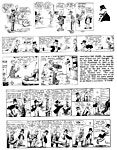 |
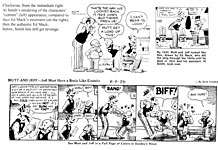 |
In developing his own stylistic treatment, he modeled the construction of the characters on Mack’s—their way of walking and standing; he elongated Mutt’s nose a little and thinned it out, but it was in inking the drawings that Scancarelli streamlined the strip’s appearance and modernized it. He added just a little cross-hatching and fine-line feathering along the edges, enough to give the drawings an antique gloss, but his flexible brush strokes, waxing and waning as they delineated the figures in bold outline, burnished Mutt and Jeff to a throughly up-to-date sheen.
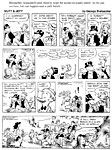 |
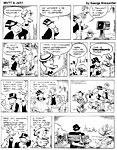 |
All
the effort Breisacher and Scancarelli devoted to the strip came, alas, to
naught. The circulation of Mutt and Jeff did
not climb miraculously, and in June 1983, a syndicate official phoned
Breisacher and invited him to lunch in New York. Breisacher flew up and had
lunch, during which, the syndicate factotum, in effect, fired the cartoonist.
Breisacher,
bemused by the coincidence of the similar circumstances of his hiring and his
firing, remarked that “it was the first time I had to fly to get fired.”
But
he wasn’t so much fired as he was retired. “The syndicate guy told George we
could continue it if we wanted to,” Scancarelli said, “but at a considerably
reduced rate. Only about half of what we’d been getting. We were splitting only
$150-200 a week as it was, and when we talked it over, we decided—six dailies
and a Sunday strip—it was too much work for too little recompense. So we gave
it up.” And so did Field Newspaper Syndicate.
Afterwards,
Scancarelli joked that he had single-handedly killed the famed strip. The gag
on June 23 had been his and his alone. Breisacher had evidently taken the day
off. “I wrote it and drew it myself,” Jim exclaimed, “and two days later, the
feature came to an end! I didn’t think the June 23 strip had been that bad!”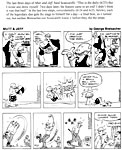
After
the demise of Mutt and Jeff, Breisacher
concocted his second tv-related strip, Channel
One, which he did just for the Observer; by 1988, he was doing another Observer-only
strip, this one, Ozone, offering
off-beat comedy appeared three times a week.  He also began devoting more and more of his spare
time to the National Cartoonists Society, which he had joined in 1973. He
started the Southeast chapter of NCS in 1990, the year after he took on the
editorship of The Cartoonist. He
edited the newsletter for the next nine years, then served as NCS president,
1997-99. He retired from the Observer in 2000 and died in 2003, a respected and revered member of NCS.
He also began devoting more and more of his spare
time to the National Cartoonists Society, which he had joined in 1973. He
started the Southeast chapter of NCS in 1990, the year after he took on the
editorship of The Cartoonist. He
edited the newsletter for the next nine years, then served as NCS president,
1997-99. He retired from the Observer in 2000 and died in 2003, a respected and revered member of NCS.
In
1986, Scancarelli inherited Gasoline
Alley and sustained the strip’s King-crafted homespun tone and Moore-like
crisp visuals, winning the NCS Best Story Strip Plaque in 1989. And he’s still
at it. Next year, 2008, Gasoline Alley will
be ninety on November 24, and Scancarelli will have been working on it for 29
years (signing it for 22), just a year short of his predecessor’s mark: Moores
worked on the strip for 30 years, signing it for 26. Says Scancarelli about the
writing of the Gasoline Alley: “Frank King and Dick both left very indelible
fingerprints on these characters. Their
personalities are so set that they act out the stories themselves. I just throw them into a situation, and they
go about doing whatever they’re going to do.”
Scancarelli
has done stories on such topical issues as deafness (Walt’s) and
naturalization, and he has sent members of the ensemble off on some fairly wild
adventures, too. A passionate fan of his
medium, he often devotes Sunday strips (no longer “pages’) to nostalgic
evocations of the comics of yesteryear, and he draws every installment, daily
or Sunday, with painstaking thoroughness, seemingly in defiance ofthe
hostility to cartoon art on any scale that prevails throughout the newspaper
industry. Mutt and Jeff, burnished into modernity by Scancarelli’s fluid line,
make periodic appearances in the strip. They and numerous of their vintage
paper-and-ink fellowship reside nearby at the Comic Strip Characters Retirement
Home, where their best friend, Walt Wallet, Gasoline
Alley’s senior citizen, comes to visit every so often. But even when the
gangly Mutt and the diminutive Jeff are out of sight, they’re scarcely out of
the nation’s consciousness: whenever we see a tall man with a short friend, we
cannot help but think of Mutt and Jeff. They’ve joined the immortals.
to cartoon art on any scale that prevails throughout the newspaper
industry. Mutt and Jeff, burnished into modernity by Scancarelli’s fluid line,
make periodic appearances in the strip. They and numerous of their vintage
paper-and-ink fellowship reside nearby at the Comic Strip Characters Retirement
Home, where their best friend, Walt Wallet, Gasoline
Alley’s senior citizen, comes to visit every so often. But even when the
gangly Mutt and the diminutive Jeff are out of sight, they’re scarcely out of
the nation’s consciousness: whenever we see a tall man with a short friend, we
cannot help but think of Mutt and Jeff. They’ve joined the immortals.
Some of the
foregoing appeared as a chapter in my book, The Art of the Funnies, but that material has been extensively supplemented here with
biographical information about Smith and Breisacher and Scancarelli, plus more
information about Fisher. But if this sort of expedition through the history of
the medium gives you pleasure, you’ll be happy to know there’s more of the
same, cover-to-cover, in The Art of the Funnies, an advertisement for which appears here.

send e-mail to R.C. Harvey
art of the comic book - art of the funnies - reviews - order form - rants & raves - Harv's Hindsights - return to main page